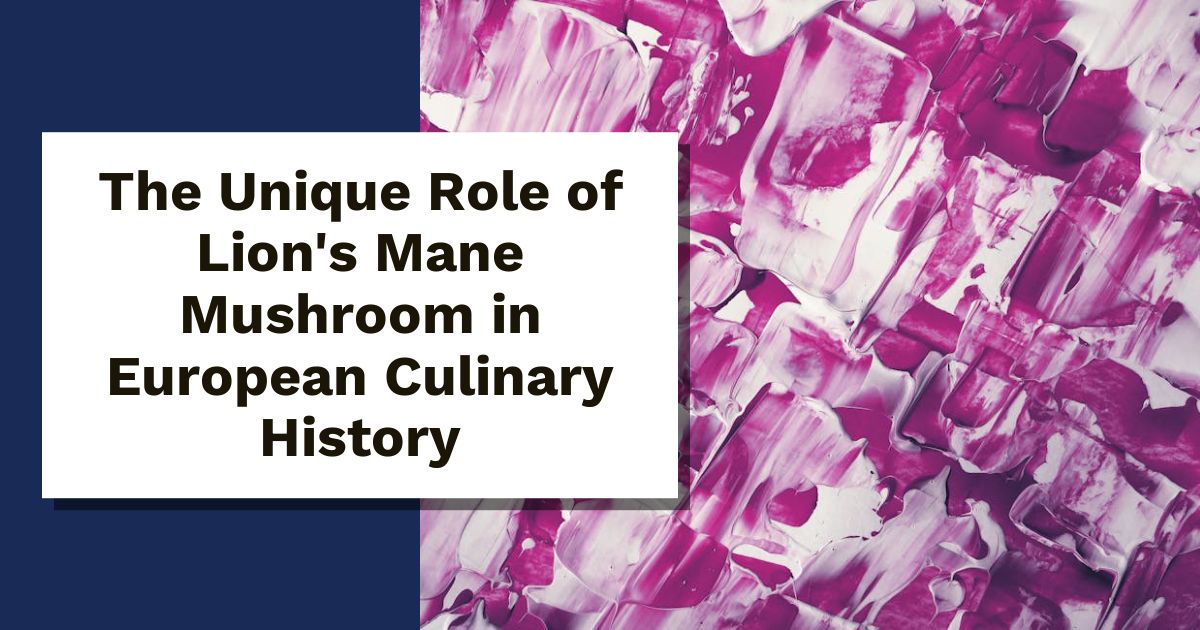Lion’s Mane mushroom is more than just a curiosity in European kitchens; it’s a rare delicacy with a rich culinary history. Have you ever wondered how such a unique ingredient found its way into traditional dishes?
This post takes you on a journey through its intriguing past. From ancient recipes to modern kitchens, Lion’s Mane has woven itself into the fabric of European cuisine. You’ll learn about its flavors, nutritional benefits, and the cultures that cherish it.
Get ready to discover why chefs and food lovers alike are reviving this stunning mushroom. Whether you’re an adventurous eater or just curious, you’ll find something to savor in this exploration of Lion’s Mane’s culinary role.
What is Lion’s Mane Mushroom?
Lion’s Mane mushroom, known scientifically as Hericium erinaceus, is not just a visual wonder. It carries a unique charm that has caught the attention of chefs and food enthusiasts in Europe. This mushroom is easily recognizable due to its stunning appearance and captivating flavor. Let’s dig into the details that make Lion’s Mane stand out.
Physical Characteristics
The first thing you notice about Lion’s Mane is its distinctive look. Picture a fluffy white cloud that’s been plucked from the sky. This mushroom resembles a lion’s mane—hence the name—with long, cascading spines that dangle down in delightful clusters. It can grow up to 12 inches in size, creating a striking presence on any dish.
Here are some key features to help you identify it:
- Color: Bright white to cream, gradually darkening as it matures.
- Shape: Round and irregular, with long, dangling spines.
- Texture: Soft and feathery, almost like a plush toy.
- Growth: Typically found on decaying hardwood trees, adding to its appeal as a foraged delight.
If you want more insights into its unique characteristics, you can check out this comprehensive guide.
Taste and Texture
Now, let’s talk about the flavor. Have you ever tried a mushroom that tasted like a cross between seafood and a savory dish? Lion’s Mane delivers this unique profile. Its taste is often described as mild, reminiscent of shellfish, which makes it a favorite among those looking for a seafood substitute.
When it comes to texture, Lion’s Mane mushrooms shine. They’re:
- Meaty: A satisfying chew that mimics the texture of chicken, perfect for those who enjoy heartier meals.
- Tender: Cooked to perfection, they maintain a delightful bounce, making them a pleasure to eat.
- Versatile: Works beautifully in various dishes, from stir-fries to creamy pastas.
For more on the taste experience, you can explore this taste profile article.
Lion’s Mane mushroom is truly a gem in European culinary history, offering not just a feast for the eyes but also for the palate.
Historical Use in Europe
Lion’s Mane mushroom has a journey through European culinary history that is both rich and fascinating. From medieval times to the Renaissance, this mushroom has made its mark in unexpected ways. Let’s explore its historical use in detail.
Medieval Culinary Practices
During the medieval period, cooking was more about sustenance than culinary art. Still, Lion’s Mane was valued as both food and medicine. Recipes often included mushrooms to add flavor and texture. People believed mushrooms could offer health benefits, making them a staple in various dishes.
Cooks used Lion’s Mane in several ways. Here are some medieval practices:
- Stews and Soups: Lion’s Mane would be added to rich, meaty stews. Its unique texture gave a hearty bite.
- Herbal Remedies: This mushroom was likely included in potions and remedies due to its nutritional benefits.
- Foraged Frenzy: People often foraged for mushrooms, and Lion’s Mane was among the favorites, enhancing the flavor of whatever they cooked.
For a taste of this historical cooking style, you might enjoy this Easy Sauteed Lion’s Mane Mushroom Recipe.
Renaissance Rediscovery
Fast forward to the Renaissance, and a newfound appreciation for food, including mushrooms, emerged. Chefs became explorers in their own right, experimenting with new ingredients and techniques. This period saw an explosion of culinary creativity across Europe, leading to a revival of interest in mushrooms.
Why did Lion’s Mane resurface? Here are a few reasons:
- Horticultural Innovation: Advances in cultivation allowed chefs to grow mushrooms more easily.
- Culinary Exchanges: Trade routes opened up, introducing a variety of flavors and teachings from different cultures.
- Artistic Expression: Cooking shifted towards art, with chefs eager to impress patrons with unique flavors.
Interested in understanding more about this shift? Check out this brief cultural history of the mushroom.
Regional Variations
Lion’s Mane mushroom didn’t just stay in one spot. Different European regions embraced it in unique ways. How you cook and enjoy Lion’s Mane can vary tremendously from Italy to Scandinavia.
Here are some regional twists on its use:
- Northern Europe: Here, the mushroom often appears in hearty dishes, paired with potatoes or root vegetables.
- Mediterranean Cuisine: In southern regions, it may be sautéed with olive oil and garlic, showcasing its seafood-like flavor.
- ** Eastern European Dishes**: Lion’s Mane is often found in traditional dumplings or comforting soups.
This delicious ingredient is not just a historical curiosity; it’s a wonderful addition to various modern dishes. If you’re eager to experiment, try this Lion’s Mane Mushroom Steaks with Balsamic Pan Sauce to get a taste of its rich past.
By exploring Lion’s Mane’s history, we can appreciate its culinary versatility and flavor. The journey through time gives us insight into how this rare ingredient has made its way back into modern kitchens, proving that some flavors never go out of style.
Culinary Applications
Lion’s Mane mushroom isn’t just a pretty face in the kitchen. This remarkable fungus is versatile and elevates a variety of dishes. Its unique taste and texture make it a favorite among chefs and home cooks alike. Let’s look at how Lion’s Mane finds its way into soups, sautéed dishes, and gourmet recipes that excite the palate.
Soups and Stews
Imagine a cozy evening with a steaming bowl of soup, and now picture it enhanced by the addition of Lion’s Mane mushroom. This mushroom brings a certain depth to liquid dishes.
When simmered, Lion’s Mane releases its subtle flavor, enriching the broth. Whether in a classic mushroom soup or a hearty stew, it adds a velvety texture that complements meaty ingredients beautifully. Here’s how Lion’s Mane shines in these dishes:
- Flavor Boost: Its seafood-like notes enhance the overall taste profile.
- Texture Contrast: Lion’s Mane holds up well in warm liquids, providing a satisfying bite amidst the creaminess or warmth of the dish.
- Nutritional Benefits: Adding Lion’s Mane not only elevates taste but also boosts the nutritional value of your meal.
For an inspiring soup recipe, you can try this guide on Cooking Lion’s Mane Mushroom.
Sautéed Dishes
Let’s talk about the magic of sautéing with Lion’s Mane. This cooking method brings out the best in the mushroom’s texture and flavor. When sautéed, Lion’s Mane turns golden brown, becoming crisp on the outside while staying tender inside.
Here are the benefits of using Lion’s Mane in sautéed dishes:
- Meaty Flavor: It acts as a satisfying substitute in vegetarian meals, mimicking the taste and texture of crab or chicken.
- Quick Cooking: Sautéing allows for fast meal prep—perfect for busy weeknights.
- Versatile Pairings: Lion’s Mane pairs well with garlic, herbs, and even a splash of wine, making it easy to incorporate into your favorite recipes.
For more tips on sautéing Lion’s Mane, check out this article on How to Cook Lion’s Mane Mushrooms.
Gourmet Recipes
Now, let’s venture into the gourmet territory. Lion’s Mane can elevate an ordinary dish to extraordinary heights. Its impressive texture and taste entice even the most discerning palates. Here are a couple of unique gourmet recipes you can try at home:
- Lion’s Mane Mushroom Steaks with Balsamic Pan Sauce
- Slice the mushroom into thick “steaks.”
- Sear them in a hot pan with olive oil and butter until golden.
- Drizzle with balsamic glaze for a rich, tangy finish.
- Check out this detailed recipe here.
- Creamy Lion’s Mane Risotto
- Slowly cook Arborio rice, adding broth gradually to achieve creaminess.
- Incorporate sautéed Lion’s Mane for flavor and texture.
- Finish with a touch of Parmesan and fresh herbs for added richness.
For more gourmet inspirations, explore this collection of Lion’s Mane mushroom recipes.
Lion’s Mane mushroom is a remarkable culinary ingredient that transforms everyday recipes into something special. Whether you’re simmering a comforting soup or preparing a gourmet dish, this mushroom is sure to impress.
Health Benefits
Lion’s Mane mushroom isn’t just a culinary delight; it’s also packed with health benefits. Let’s uncover what makes this unique ingredient so special for our bodies and minds.
Nutritional Value
Lion’s Mane mushroom is not just low in calories; it comes loaded with nutrients. Here’s a breakdown of some key nutrients you’ll find in this remarkable fungus:
- Calories: Approximately 35 calories per 100g.
- Carbohydrates: About 7g, making it a great option for a low-carb diet.
- Protein: Contains around 2.4g, contributing to your daily intake.
- Fiber: Offers 4.4g, supporting digestive health.
- Fats: Less than 1g, keeping it heart-healthy.
- Vitamins: High in Biotin (Vitamin B7), essential for energy production.
- Minerals: Includes Magnesium, Potassium, and Phosphorus, which are vital for various bodily functions.
For more detailed information, explore this comprehensive guide.
Cognitive Benefits
When it comes to brain health, Lion’s Mane has the potential to stimulate cognitive function. Research indicates that it may enhance memory, focus, and overall mental clarity.
Here’s why it’s gaining attention:
- Promotes Nerve Growth: Compounds in Lion’s Mane, like hericenones and erinacines, may support the growth of brain cells.
- Boosts Memory: Studies suggest that regular consumption could help improve memory in healthy individuals and those with mild cognitive impairment.
- Reduces Anxiety and Depression: There’s evidence that it helps alleviate symptoms of anxiety and mild depression, leading to improved mental well-being.
For a deeper dive into its cognitive effects, check out this detailed article.
Not only is Lion’s Mane a treasure in dishes, but its health benefits are just as enticing. By adding this mushroom to your meals, you’re not just enjoying a unique flavor; you’re treating yourself to a range of health perks, especially for your brain!
Challenges in Sourcing Lion’s Mane
Sourcing Lion’s Mane mushroom comes with its own set of challenges. This unique fungus can be found both in the wild and cultivated in controlled environments. Each sourcing method presents its pros and cons.
Wild vs. Cultivated
When it comes to Lion’s Mane, foraging in the wild and farmed varieties each offers distinct qualities. Wild Lion’s Mane, for example, thrives on decaying hardwood trees, giving it a robust, earthy flavor. On the other hand, cultivated varieties are typically grown on sawdust or other substrates, which can yield a more consistent product. Here’s a closer look at both:
- Flavor and Texture: Wild Lion’s Mane is often celebrated for its intense flavor. It can have a more varied texture due to environmental factors. Cultivated versions tend to be milder and have a more uniform texture.
- Availability: Wild Lion’s Mane can be harder to find, as it depends on the right seasonal and environmental conditions. Cultivated mushrooms are available year-round, making them more accessible for culinary use.
- Cost: Wild foraged Lion’s Mane generally comes at a higher price point due to its rarity and the labor involved in foraging. Cultivated options are more affordable and widely available.
- Environmental Impact: Wild foraging can sometimes lead to overharvesting, impacting ecosystems. Conversely, cultivated mushrooms can utilize agricultural waste, supporting sustainable practices. For a better understanding of wild foraging, check out this guide on Foraging Wild Lion’s Mane Mushroom.
Each option has its appeal. Ultimately, the choice between wild and cultivated Lion’s Mane depends on flavor preferences, availability, and personal ethics in sourcing ingredients.
Sustainability Concerns
Sustainability is a crucial concern when sourcing Lion’s Mane. The environmental impact varies significantly between wild foraging and cultivated production.
- Overharvesting: In the wild, Lion’s Mane can be threatened by overharvesting. This practice can disrupt local ecosystems and diminish future mushroom populations.
- Cultivation Practices: Farming Lion’s Mane can reduce pressure on wild populations. Many producers use sustainable methods, recycling agricultural by-products and minimizing land use. For insights into sustainability in mushroom farming, visit Mushroom Sustainability Research.
- Water Usage: Cultivating Lion’s Mane is water-efficient compared to traditional crops. This feature makes it an attractive option for environmentally conscious consumers. To explore its ecological impact further, check out this article on the Impact of the Mushroom Industry on the Environment.
As demand for Lion’s Mane grows, understanding these sustainability issues becomes increasingly important. Both foragers and farmers must balance consumption with environmental responsibility, ensuring that future generations can enjoy this rare culinary gem.
Conclusion
As we wrap up this exploration of Lion’s Mane mushroom in European culinary history, it’s clear that this unique ingredient holds a special place on the table. Its journey from ancient recipes to modern kitchens is not just interesting—it’s a testament to its enduring appeal.
A Culinary Treasure
Lion’s Mane mushroom is more than just food; it’s a culinary treasure. Its striking appearance and flavor have captivated chefs and home cooks alike. The balance between its mild, seafood-like taste and meaty texture allows it to shine in multiple dishes.
Rich Heritage
From medieval stews to Renaissance gourmet creations, Lion’s Mane has a rich heritage. Each region in Europe offers a unique twist on how it’s prepared. This versatility proves that Lion’s Mane is not just a fleeting trend but a beloved ingredient with historical significance.
Reviving Old Traditions
With a newfound interest in foraging and ancient cooking methods, Lion’s Mane is making a comeback. It’s thrilling to see a once-rare mushroom becoming a staple in contemporary cooking. This evolution encourages chefs and home cooks to explore the past while creating new culinary experiences.
To dive deeper into the historical significance of Lion’s Mane, take a moment to explore these resources: The History and Benefits of Lion’s Mane and Hericium erinaceus: A Medicinal Fungus.
Dr. Cordy is a passionate advocate for the incredible benefits of Lion's Mane mushrooms, blending scientific insight with a deep enthusiasm for natural wellness. When he’s not exploring the latest research on functional fungi, you’ll find him chasing waves as an avid surfer, strategizing over chess matches, or embarking on outdoor adventures that fuel his curiosity and love for nature. A devoted dog dad and lifelong explorer, Dr. Cordy combines his diverse passions with a mission to educate and inspire others about the transformative potential of Lion’s Mane mushrooms. You can unearth his latest Lion's Mane insights here. 🍄


